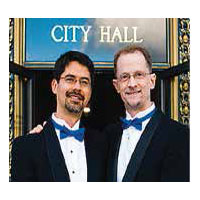 By John Lewis and Stuart Gaffney–
By John Lewis and Stuart Gaffney–
Last week, the U.S. Supreme Court faced the reality of the vast diversity of human experience when it comes to gender, sexual orientation, and gender identity in a way it had never done before. The Court held oral arguments in cases regarding whether anti-LGBT employment discrimination violates Title VII of the 1964 Civil Rights Act.
As we explained in the last edition, resolution of the cases should be straightforward. As Justice Kagan put it during the argument, Title VII provides an “extremely simple test”; that is, “would the same thing would have happened to you if you were of a different sex?”
Kagan made clear that the employer in the case before the Court violated Title VII because it fired a highly valued, long-term employee simply because he “was a man who loved other men.” The employer wouldn’t have done so if the employee were a woman who loved men.
Similarly, counsel for Aimee Stephens, whose employer fired her because she was transgender, explained that her employer fired her based on the “ultimate sex stereotype” that a person should be cisgender. Counsel explained that Stephen’s employer fired her “because she had a male sex assigned at birth” and would not have done so had she been designated female at birth.
The cases strikingly illuminate a central root of modern anti-LGBT discrimination: queer people transgress deeply engrained, rigid gender norms that remain widespread. A primary reason that LGBTIQ people suffer discrimination is that we are living proof that all people are, in fact, not straight, cisgender men or women who live on a strict gender binary. People are much more beautifully nuanced, complex, and dynamic than those confinements.
We don’t know if a majority of the Court will recognize this substantive underpinning of the cases, but the language of Title VII is clear, something that Trump’s arch conservative Court appointee Neil Gorsuch even seemed to acknowledge. Indeed, the outcome of these cases appears to hinge on whether Gorsuch possesses the moral and intellectual integrity to stay true to his long professed conviction that when the actual words of a statute are unambiguous, the court must follow those words rather than attempt to glean the subjective intentions of the legislators who enacted the law.
Gorsuch, however, seemed to despair during oral argument that enforcing the plain words of the statute could lead to “massive social upheaval.” And questions regarding the use of bathrooms (and, to a lesser extent, workplace dress codes) took center stage during significant parts of the argument. Even Justice Sotomayor, who seemed clearly in favor of the LGBT plaintiffs, identified the bathroom question as a “difficult issue.”
She recognized a transgender person’s “genuine” need to use the bathroom that comports with their gender identity, but asserted that “there are other women who are made uncomfortable, and not merely uncomfortable, but who would feel intruded upon if someone who still had male characteristics walked into their bathroom.”
The extensive discussion of bathroom access is based on ignorance. Americans have been sharing bathrooms with transgender people without incident for a long time and weren’t even aware they were doing it. Anti-LGBTIQ conservatives recently created transgender bathroom panic as a political scare tactic to fight civil rights legislation protecting transgender people, most prominently Houston’s Proposition 1 in 2015.
Separate bathrooms for blacks and whites was a prominent aspect of racist Jim Crow laws, because many white people felt not just “uncomfortable” but “intruded upon,” to say the least, by sharing bathrooms with blacks. The fears and prejudices of many white people were not a legitimate justification for such laws that were eventually struck down as discriminatory. A right-wing political scare tactic should not be a basis today for denying LGBTIQ people their basic civil rights that federal law mandates.
The outcome of the cases may ultimately depend on whether Justice Kagan can successfully use her coalition-building skills to convince Gorsuch, and possibly Kavanaugh (who said too little during the arguments to discern where he stood on the cases), to come together to create a favorable majority. Kagan was lauded for her ability to unify people when she was nominated for the Court nearly a decade ago.
For instance, on the question of statutory interpretation, Kagan declared a few years ago that “we are all textualists now” because of the influence of Gorsuch’s predecessor Antonin Scalia, whom Gorsuch greatly admired. For years, Gorsuch has declared that judges should interpret statutes based on “what ‘the words on the paper say’” and not their personal “views of optimal social policy or what the statute ‘should be.’” Now he has a chance to join Kagan and to stand by his principles.
And Kagan has known Kavanaugh for years since she hired him to teach at Harvard Law School when she was the school’s dean. When Kavanaugh was nominated for the Court, he thanked her for the opportunity to teach at the law school, and the two of them were seen laughing together on Kavanaugh’s first day at the Court.
The Justices’ words at oral argument provide only a glimpse at what they may be thinking about a case, and do not serve as an accurate predictor of how they may rule. We know that if the Justices abide by the creed engraved atop the edifice of the Supreme Court, “Equal Justice Under Law,” LGBTIQ people across the nation will soon be protected from employment discrimination.
John Lewis and Stuart Gaffney, together for over three decades, were plaintiffs in the California case for equal marriage rights decided by the California Supreme Court in 2008. Their leadership in the grassroots organization Marriage Equality USA contributed in 2015 to making same-sex marriage legal nationwide.
Recent Comments